[1]
Christiansen E L, Kerr J H. (2001) Ballistic limit equations for spacecraft shielding, Int. J. Impact Engng., 26, 93-104.
DOI: 10.1016/s0734-743x(01)00070-7
Google Scholar
[2]
Piekutowski A J. (1996) Formation and description of debris clouds produced by hypervelocity impact, NASA Contractor Report 4707, February.
Google Scholar
[3]
Corvonato E, Destefanis R and Faraud M. (2001) Integral model for the description of the debris cloud structure and impact, Int. J. Impact Engng., 26, 115-128.
DOI: 10.1016/s0734-743x(01)00074-4
Google Scholar
[4]
Piekutowski A.J. (1993) Characteristics of debris clouds produced by hypervelocity impact of aluminum spheres with thin aluminum plates, Int. J. Impact Engng., 14, 573-586.
DOI: 10.1016/0734-743x(93)90053-a
Google Scholar
[5]
Zhang W., Pang B.J., et al (2001) Investigation into material state characterization of debris cloud created by cylindrical projectile impact on bumper, Chinese Space Science and Technology, 21(3), 53-61.
Google Scholar
[6]
Zhang W., Pang B.J., et al (2002) Investigation into velocity characterization of debris cloud created by projectile impact on bumper, Chinese Space Science and Technology, 22(2), 67-71.
Google Scholar
[7]
Hayhurst C.J., Clegg R.A. (1997) Cylindrically symmetric SPH simulations of hypervelocity impacts on thin plates, Int. J. Impact Engng., 20, 337-348.
DOI: 10.1016/s0734-743x(97)87505-7
Google Scholar
[8]
Hiermaier S., Konke D., Stilp A.J. and Thoma K. (1997) Computational simulation of the hypervelocity impact of al-spheres on thin plates of different materials, Int. J. Impact Engng., 20, 363-374.
DOI: 10.1016/s0734-743x(97)87507-0
Google Scholar
[9]
Clegg R A, White D M, Riedel W (2005) Hypervelocity impact damage prediction in composites part I - material model and characterization, Int. J. Impact Engng. 2005, in print.
Google Scholar
[10]
Zhang W., Pang B.J., Jia B. (2004) Numerical simulation of debris cloud produced by hypervelocity impact of projectile on bumper, Chinese Journal of High Pressure Physics, 18, 47-52.
Google Scholar
[11]
Zhang W., Guan G.S., Pang B.J., et al (2004) Investigation into debris cloud characterizations for oblique hypervelocity impact of projectiles on bumper, Journal of Harbin Institute of Technology, 11(4), 372-376.
Google Scholar


